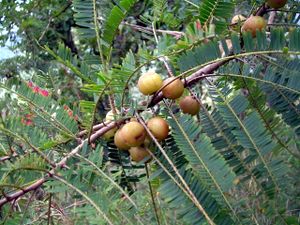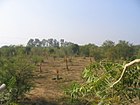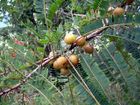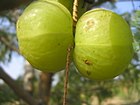Note: This is a project under development. The articles on this wiki are just being initiated and broadly incomplete. You can Help creating new pages.
Difference between revisions of "Phyllanthus emblica - Triphala"
(→External Links) |
(→External Links) |
||
| (2 intermediate revisions by the same user not shown) | |||
| Line 1: | Line 1: | ||
[[File:Phyllanthus officinalis.jpg|thumb|right| ''Phyllanthus officinalis'', ''Triphala'']] | [[File:Phyllanthus officinalis.jpg|thumb|right| ''Phyllanthus officinalis'', ''Triphala'']] | ||
| − | |||
'''Amalaki''' is an Ayurvedic herbal rasayana formula consisting of equal parts of three myrobalans taken without seed. | '''Amalaki''' is an Ayurvedic herbal rasayana formula consisting of equal parts of three myrobalans taken without seed. | ||
| − | |||
==Uses== | ==Uses== | ||
{{Uses|Diabetes}}, {{Uses|Jaundice}}, {{Uses|Stomachache}}, {{Uses|Gynaecological disorder}}, {{Uses|Cough}}, {{Uses|Mouth ulcer}}, {{Uses|Heart problems}}, {{Uses|Diarrhea}}, {{Uses|Asthma}}, {{Uses|Cold}}, {{Uses|Acidity}} | {{Uses|Diabetes}}, {{Uses|Jaundice}}, {{Uses|Stomachache}}, {{Uses|Gynaecological disorder}}, {{Uses|Cough}}, {{Uses|Mouth ulcer}}, {{Uses|Heart problems}}, {{Uses|Diarrhea}}, {{Uses|Asthma}}, {{Uses|Cold}}, {{Uses|Acidity}} | ||
==Parts Used== | ==Parts Used== | ||
| − | {{Parts Used| | + | {{Parts Used|Leaves}}, {{Parts Used|Fruit}}. |
==Chemical Composition== | ==Chemical Composition== | ||
| − | Triacontanol (1), Triacontanoic acid (2), β-Amyrin ke- tone (3), Betulonic acid (4), Daucosterol (5), Lupeol acetate (6), β-Amyrin-3-palmitate (7), Gallic acid (8), Betulinic acid (9), Ursolic acid (10), Oleanolic acid (11), Quercetin (12) and Rutin | + | Triacontanol (1), Triacontanoic acid (2), β-Amyrin ke- tone (3), Betulonic acid (4), Daucosterol (5), Lupeol acetate (6), β-Amyrin-3-palmitate (7), Gallic acid (8), Betulinic acid (9), Ursolic acid (10), Oleanolic acid (11), Quercetin (12) and Rutin etc<ref name="chemical composition"/> |
==Common names== | ==Common names== | ||
| Line 39: | Line 37: | ||
===Flower=== | ===Flower=== | ||
| − | {{Flower|Unisexual|2-4cm long| | + | {{Flower|Unisexual|2-4cm long|Reddish|5|Flowering from March-April}} |
===Fruit=== | ===Fruit=== | ||
| − | {{Fruit||7–10 mm | + | {{Fruit||7–10 mm long pome|Fruiting May onwards|A depressed-globose drupe|Many}} |
===Other features=== | ===Other features=== | ||
| Line 54: | Line 52: | ||
==How to plant/cultivate== | ==How to plant/cultivate== | ||
| − | A plant mainly of the hot, tropical lowlands, succeeding in both humid and semi-arid areas<ref name="How to plant/cultivate"/> | + | A plant mainly of the hot, tropical lowlands, succeeding in both humid and semi-arid areas.<ref name="How to plant/cultivate"/> |
==Commonly seen growing in areas== | ==Commonly seen growing in areas== | ||
| Line 72: | Line 70: | ||
<references> | <references> | ||
| − | <ref name="chemical composition">[https://www.ncbi.nlm.nih.gov/pubmed/26415402 | + | <ref name="chemical composition">[https://www.ncbi.nlm.nih.gov/pubmed/26415402 Chemical constituents]</ref> |
| − | <ref name="Leaf">[https://indiabiodiversity.org/species/show/31625 | + | <ref name="Leaf">[https://indiabiodiversity.org/species/show/31625 Morphology]</ref> |
| − | <ref name="How to plant/cultivate">[https://www.pfaf.org/user/Plant.aspx?LatinName=Phyllanthus+emblica | + | <ref name="How to plant/cultivate">[https://www.pfaf.org/user/Plant.aspx?LatinName=Phyllanthus+emblica Cultivation details]</ref> |
</references> | </references> | ||
==External Links== | ==External Links== | ||
* [http://tropical.theferns.info/viewtropical.php?id=Phyllanthus+emblica Phyllanthus emblica on useful trophical plants] | * [http://tropical.theferns.info/viewtropical.php?id=Phyllanthus+emblica Phyllanthus emblica on useful trophical plants] | ||
| − | * [http://www.fao.org/docrep/004/ab777e/ab777e05.htm Phyllanthus emblica on | + | * [http://www.fao.org/docrep/004/ab777e/ab777e05.htm Phyllanthus emblica on Species for home garden] |
* [https://www.prota4u.org/database/protav8.asp?g=pe&p=Phyllanthus+emblica+L. Phyllanthus emblica on prota4u.org] | * [https://www.prota4u.org/database/protav8.asp?g=pe&p=Phyllanthus+emblica+L. Phyllanthus emblica on prota4u.org] | ||
Latest revision as of 15:41, 1 July 2020
Amalaki is an Ayurvedic herbal rasayana formula consisting of equal parts of three myrobalans taken without seed.
Contents
- 1 Uses
- 2 Parts Used
- 3 Chemical Composition
- 4 Common names
- 5 Properties
- 6 Habit
- 7 Identification
- 8 List of Ayurvedic medicine in which the herb is used
- 9 Where to get the saplings
- 10 Mode of Propagation
- 11 How to plant/cultivate
- 12 Commonly seen growing in areas
- 13 Photo Gallery
- 14 References
- 15 External Links
Uses
Diabetes, Jaundice, Stomachache, Gynaecological disorder, Cough, Mouth ulcer, Heart problems, Diarrhea, Asthma, Cold, Acidity
Parts Used
Chemical Composition
Triacontanol (1), Triacontanoic acid (2), β-Amyrin ke- tone (3), Betulonic acid (4), Daucosterol (5), Lupeol acetate (6), β-Amyrin-3-palmitate (7), Gallic acid (8), Betulinic acid (9), Ursolic acid (10), Oleanolic acid (11), Quercetin (12) and Rutin etc[1]
Common names
| Language | Common name |
|---|---|
| Kannada | Betta Nelli |
| Hindi | Aonla, Amla |
| Malayalam | Nellikka, Amalakam |
| Tamil | Konkam |
| Telugu | Amalakamu |
| Marathi | NA |
| Gujarathi | NA |
| Punjabi | NA |
| Kashmiri | NA |
| Sanskrit | Amalakah |
| English | Indian Gooseberry |
Properties
Reference: Dravya - Substance, Rasa - Taste, Guna - Qualities, Veerya - Potency, Vipaka - Post-digesion effect, Karma - Pharmacological activity, Prabhava - Therepeutics.
Dravya
Rasa
Tikta (Bitter), Kashaya (Astringent)
Guna
Laghu (Light), Ruksha (Dry), Tikshna (Sharp)
Veerya
Ushna (Hot)
Vipaka
Katu (Pungent)
Karma
Kapha, Vata
Prabhava
Habit
Identification
Leaf
| Kind | Shape | Feature |
|---|---|---|
| Simple | Alternate | Bark light grey and exfoliating. Leaf feathery, smaller towareds the apex and the base, tip reddish |
Flower
| Type | Size | Color and composition | Stamen | More information |
|---|---|---|---|---|
| Unisexual | 2-4cm long | Reddish | 5 | Flowering from March-April |
Fruit
| Type | Size | Mass | Appearance | Seeds | More information |
|---|---|---|---|---|---|
| 7–10 mm long pome | Fruiting May onwards | A depressed-globose drupe | Many | {{{6}}} |
Other features
List of Ayurvedic medicine in which the herb is used
- Vishatinduka Taila as root juice extract
Where to get the saplings
Mode of Propagation
How to plant/cultivate
A plant mainly of the hot, tropical lowlands, succeeding in both humid and semi-arid areas.[3]
Commonly seen growing in areas
Mixed forests, Drier forests, Dry open sparse forests or scrub.
Photo Gallery
References
External Links
- Ayurvedic Herbs known to be helpful to treat Diabetes
- Ayurvedic Herbs known to be helpful to treat Jaundice
- Ayurvedic Herbs known to be helpful to treat Stomachache
- Ayurvedic Herbs known to be helpful to treat Gynaecological disorder
- Ayurvedic Herbs known to be helpful to treat Cough
- Ayurvedic Herbs known to be helpful to treat Mouth ulcer
- Ayurvedic Herbs known to be helpful to treat Heart problems
- Ayurvedic Herbs known to be helpful to treat Diarrhea
- Ayurvedic Herbs known to be helpful to treat Asthma
- Ayurvedic Herbs known to be helpful to treat Cold
- Ayurvedic Herbs known to be helpful to treat Acidity
- Herbs with Leaves used in medicine
- Herbs with Fruit used in medicine
- Herbs with common name in Kannada
- Herbs with common name in Hindi
- Herbs with common name in Malayalam
- Herbs with common name in Tamil
- Herbs with common name in Telugu
- Herbs with common name in Sanskrit
- Herbs with common name in English
- Habit - Herb
- Index of Plants which can be propagated by Seeds
- Index of Plants which can be propagated by Cuttings
- Herbs that are commonly seen in the region of Mixed forests
- Herbs that are commonly seen in the region of Drier forests
- Herbs that are commonly seen in the region of Dry open sparse forests or scrub
- Herbs
- Ayurvedic herbs that don't have flower, fruit and leaf photos
- Ayurvedic herbs that don't have seed photos
- Repeat plant
- Phyllanthaceae





